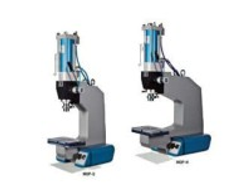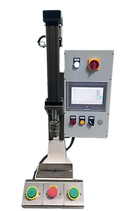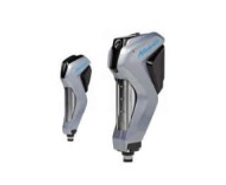- changdeliequip
- Aug 22, 2024
- 4 min read

Pneumatic toggle presses have long been a staple in various manufacturing industries, and they are known for their precision, efficiency, and versatility. As technology evolves, so does the machinery that powers our production lines. In recent years, there have been significant advancements in pneumatic toggle press technology, leading to more sophisticated, reliable, and user-friendly machines. In this article, we'll explore the latest innovations in pneumatic toggle press technology and what we can expect to see in the future. Whether you're a seasoned professional or new to the industry, understanding these advancements will help you stay ahead of the curve and make informed decisions for your business.
1. The Rise of Smart Pneumatic Toggle Presses
Integrating innovative technology is one of the most exciting developments in pneumatic toggle presses. Innovative pneumatic toggle presses have sensors, data analytics, and IoT (Internet of Things) capabilities, allowing for real-time monitoring and adjustments. These machines can automatically detect issues such as misalignment, wear, or pressure inconsistencies, alerting operators before a problem escalates. The ability to collect and analyze data also provides valuable insights into machine performance, helping businesses optimize their processes and reduce downtime.
2. Energy Efficiency and Sustainability
As industries worldwide strive to reduce their carbon footprint, energy efficiency, and sustainability have become top priorities. Modern pneumatic toggle presses are being designed with energy-saving features that minimize air consumption and reduce overall power usage. These innovations lower operational costs and align with global sustainability goals. Expect more eco-friendly pneumatic toggle presses with designs focused on minimizing environmental impact without compromising performance.
3. Enhanced Safety Features
Safety is paramount in any manufacturing environment, and advancements in pneumatic toggle press technology make these machines safer. Newer models come equipped with enhanced safety features such as emergency stop functions, protective guarding, and automated shutdown systems in case of a malfunction. Additionally, integrating innovative technology allows for real-time monitoring of safety parameters, ensuring that the machine operates within safe limits at all times.
4. Increased Automation and Robotics Integration
Automation is revolutionizing the manufacturing industry, and pneumatic toggle presses are no exception. The future will see increased integration of automation and robotics with pneumatic toggle presses, leading to fully automated production lines. Robotics integration allows for precise and consistent operations, reducing the need for manual intervention and increasing production efficiency. This shift towards automation also opens up new possibilities for customization and previously challenging tasks.
5. Modular Design for Flexibility
Flexibility is crucial in today's fast-paced manufacturing landscape. Modern pneumatic toggle presses are designed with modular components, allowing easy upgrades and customization. This modular design enables businesses to adapt their machinery to different tasks or production needs without a complete overhaul. In the future, we can expect to see even more modular and adaptable pneumatic toggle presses, offering greater flexibility and reducing the total cost of ownership.
6. Improved Precision and Control
Precision is at the heart of pneumatic toggle press operations, and recent innovations are pushing the boundaries of what these machines can achieve. Advanced control systems now allow for finer pressure, speed, and positioning adjustments, ensuring that each operation is performed with utmost accuracy. This level of precision is fundamental in industries where even the slightest deviation can result in significant quality issues. Expect continued improvements in precision and control, making pneumatic toggle presses even more reliable for high-stakes manufacturing processes.
7. Integration with Digital Twins
The concept of digital twins—virtual replicas of physical machines—is gaining traction in the manufacturing industry. By creating a digital twin of a pneumatic toggle press, operators can simulate various scenarios, optimize machine performance, and predict potential issues before they occur. This technology enables proactive maintenance and reduces downtime, leading to more efficient operations. As digital twin technology becomes more advanced, it will likely become a standard feature in future pneumatic toggle presses.
8. User-Friendly Interfaces
As technology advances, so too does the user experience. The latest pneumatic toggle presses are designed with user-friendly interfaces that make them easier to operate and maintain. Touchscreen controls, intuitive menus, and real-time feedback are just a few of the features that make these machines more accessible to operators of all skill levels. In the future, we can expect even more innovations in user interfaces, making it easier for operators to maximize the potential of their pneumatic toggle presses.
9. Customization and Specialized Applications
Every industry has unique requirements, and pneumatic toggle presses are increasingly tailored to meet these needs. Manufacturers offer more customization options, allowing businesses to choose features and configurations that best suit their applications. This trend towards specialization is expected to continue, with more pneumatic toggle presses being designed for niche markets and specific tasks. Whether you need a press for delicate operations or heavy-duty tasks, the future holds more options.
10. Cost-Effective Solutions
Finally, as technology advances, the cost of pneumatic toggle presses is expected to become more competitive. Innovations in manufacturing processes, materials, and design are driving down costs, making high-quality pneumatic toggle presses more accessible to businesses of all sizes. In the future, we expect to see more cost-effective solutions that do not compromise on quality or performance, enabling more companies to benefit from the latest advancements in pneumatic toggle press technology.
Conclusion
The future of pneumatic toggle press technology is bright, with numerous innovations set to transform how these machines are used in manufacturing. The next generation of pneumatic toggle presses will be more advanced, reliable, and user-friendly, with intelligent technology and, increased automation, enhanced safety features, and improved precision. By staying informed about these trends and investing in the latest technology, businesses can stay ahead of the competition and ensure their production processes are as efficient and effective as possible.




